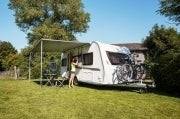Caravan Awnings NZ: How to Choose, Prices & Best Stores
Choosing a caravan awning in NZ can feel like guesswork: full or porch, poled or inflatable, shade or extra room? Add harsh UV, coastal gusts and sudden downpours, plus the risk of buying the wrong size, height or bead for your rail.
This guide gives you a clear, practical path to the right awning for your caravan and travel style. We’ll translate the specs, show you how to measure correctly, and help you match rail height and keder size, materials, weather ratings and features.
You’ll also get typical NZ price ranges, where to buy new, second-hand and replacement parts locally, when to time a deal, and the set-up, safety and care tips that make an awning last. Ready to choose with confidence? Start with how you plan to use it.
Step 1. Decide how you’ll use your awning (touring, weekenders, seasonal stays)
Start with your travel pattern. If you tour and move most days, prioritise fast set‑up, low weight and small pack size. If you mostly do weekenders, balance quick pitching with usable living space. For seasonal or long stays, maximise space and weather stability. This simple call frames every choice that follows for caravan awnings NZ buyers: type, size, frame, and materials.
Step 2. Choose the awning type: full, porch, inflatable (air), or sun canopy
There are four core styles most caravan awnings NZ buyers compare. Match the type to your trip style from Step 1—how long you stay and how often you move—so you get the right balance of space, speed and weight.
Full awnings
Maximum enclosed space and the best “extra room” feel for seasonal or long stays. They’re heavier, slower to pitch, and must be sized to your caravan’s rail length, but reward you with stability and livability.
Porch awnings
Lighter, faster and flexible for touring and weekenders. Many can be pitched by one person in around 10 minutes and fit the straight section of your awning rail, giving handy storage and shelter without the bulk.
Inflatable (air) awnings
Air-beam frames replace most poles for quick, low‑stress pitching. Great when you want more space than a porch but faster set‑up than a full poled frame; just carry a pump and peg out thoroughly.
Sun canopies
The lightest, quickest shade solution. Ideal for fair‑weather touring when you want airflow and UV protection, knowing you’re trading enclosed walls and privacy for simplicity and speed.
Step 3. Measure your caravan correctly for a perfect fit
Get the length right and everything else falls into place. For porch and inflatable caravan awnings NZ buyers should measure only the straight section of the awning rail along the roof line—awnings can’t run onto the curved rail. That number tells you which model will fit: “220/260/330/390” equals 2.2/2.6/3.3/3.9 metres. Full awnings also rely on the usable straight rail length; we’ll sort height and bead sizing in the next step.
- Pick the side first: Many UK caravans have rails on both sides, but don’t erect an awning on the gas‑flue side.
- Measure the straight run: From where the front curve ends to where the rear curve begins—end to end of the straight rail.
- Confirm clearances: Ensure the door opens freely. Windows can be covered if needed.
Step 4. Match awning height and keder/bead size to your rail
Getting height and bead right is non‑negotiable: the wrong combination won’t attach or will sit badly in wind and rain. UK awnings use a 6 mm awning bead, so confirm your rail suits that, and check the awning‑rail height before you buy—especially if your caravan isn’t a UK model.
- Confirm bead size: UK‑style caravan awnings NZ shoppers buy typically use a 6 mm bead; verify your rail matches 6 mm.
- Measure rail height: Level the caravan, then measure from ground to the awning rail along the straight section; match to the awning’s stated fit height.
- Check clearance: Ensure doors, hatches and lights clear the awning, and avoid the gas‑flue side.
- Do a feed test: If possible, slide a short section of bead into the rail to confirm fit and ease.
Step 5. Pick materials, frames and weather ratings for NZ conditions
New Zealand’s UV, coastal salt and gusty southerlies punish gear, so choose fabric and frames that suit where and how you camp. For caravan awnings NZ buyers, aim for UV resistance, reliable waterproofing, and a structure that balances strength with the speed you need on tour.
- Fabric choice: Polyester is light and quick‑drying; acrylic/polycotton tends to feel cooler and more breathable. Prioritise UV resistance and proofed panels.
- Frames: Steel is strongest (heavier), aluminium is light and corrosion‑resistant, fibreglass is light with more flex. Match strength to wind exposure.
- Seams and zips: Look for taped/sealed seams, robust zips, draught and mud skirts to keep weather out.
- Storm readiness: Ensure multiple guy points, decent pegs for sand/hard ground, and optional storm straps/extra rafters.
- Coastal use: Favour anti‑corrosion frames and rinse salt off after trips.
- Air-beam tips: Carry a pump and patch kit; peg thoroughly and avoid over‑inflation in heat.
- Ratings: If available, compare manufacturer wind guidance and waterproof (hydrostatic head) ratings before you buy.
Step 6. Choose features and layout that suit your family and site
The right features turn an awning into a liveable room. Think about how your whānau actually uses space—sleeping kids, a soggy dog, bikes, cooking on wet days, or just shade with airflow. Match the layout of caravan awnings NZ campers buy to your pitch size and your caravan’s door position so traffic flows and gear stays dry.
- Entry and flow: Multiple doors, roll‑back fronts and side panels for easy access and clear sightlines.
- Ventilation and light: Mesh doors, roof vents, and clear windows with curtains/privacy screens for NZ sun control.
- Sleeping/annexe: Zip‑on annexes or inner tents for kids/guests; confirm model compatibility before you buy.
- Wet gear and cooking: Canopies or verandah poles to create drip‑free shelter; hanging points for lights and coats.
- Ground and comfort: Draught skirt and wheel‑arch cover; choose carpet and a breathable or removable groundsheet if your campsite requires it.
- Pitchability: Zip‑out panels to reduce weight during setup; logical bagging for poles/pump.
- Utilities: Cable entry points and lamp hooks for tidy electrics.
- Stability: Storm straps, extra guy points and optional rafters for exposed coastal sites.
Step 7. Set your NZ budget: typical price ranges and what affects cost
Set a realistic budget by thinking “total cost of ownership”, not just the sticker. For caravan awnings NZ buyers, value comes from the right size, fabric and frame for your trips, plus spares, warranty and how well it stands up to our UV and wind. Prices vary widely across types and specs, so use the factors below to gauge where your spend should land.
- Awning type: Sun canopies are usually the lowest cost; porch and smaller air awnings sit mid‑range; full awnings and large air models are typically the priciest.
- Size/length: 220/260/330/390 models scale up in cost with fabric, zips and poles.
- Frame system: Air‑beam convenience generally costs more than basic poled; steel frames add strength (and cost/weight), aluminium trades some strength for lower weight and corrosion resistance.
- Fabric and UV/weather proofing: Heavier‑duty, UV‑resistant and higher waterproofing usually mean a higher price.
- Included kit: Storm straps, draught skirts, wheel‑arch covers, carpet and annex options can add to the package price.
- Brand, warranty and local support: Strong NZ aftersales and available spares reduce long‑term cost.
Step 8. Where to buy in New Zealand: comparing the best stores and timing your purchase
In New Zealand, compare caravan awnings NZ wide by checking a mix of national RV chains, specialist caravan dealers and online stores. Prioritise retailers that publish fit‑height and 6 mm bead compatibility, list porch lengths, and offer local spares and warranty handling. If you camp coastal or windy, ask about storm kits and frame options. Here’s where to look and when to buy.
- Big RV retailers: RV Super Centre — broad ranges (Fiamma, Thule, Dometic, Vango) and advice.
- Online specialists: RV World, RV Appliances, Intenze — wide selection, promos advertised, inflatable options.
- Caravan dealers: Affordable Caravans, UK Caravans, Rolleston Caravans — sizing help and parts.
- Custom builds: Cvana — bespoke awnings and enclosures when standard sizes don’t fit.
- Timing: Watch end‑of‑season clearances and holiday sales; compare package inclusions before buying.
Step 9. Buying used or sourcing replacements: how to find good second-hand deals and parts
Buying second‑hand caravan awnings in NZ can be a smart way to stretch the budget. Start with Trade Me for used listings, ask caravan dealers about clear‑outs/consignment stock, and look for ex‑demo models. For replacement parts, major RV retailers and caravan specialists often carry skirts, storm straps, rafters and inflatable spares; custom solutions are available from NZ fabricators.
- Verify fit first: 6 mm bead, correct rail height, and straight‑rail length (e.g., 220/260/330/390).
- Inspect condition: UV fade, brittle/“milky” windows, peeling seam tape, sticky zips, bent poles or tired air bladders.
- Request proof: Photos pitched, video of inflation, and a feed test into a short rail section if possible.
- Check inclusions: Draught skirt, wheel‑arch cover, pegs/guys, storm straps, pump/valves, repair kit, manuals.
- Budget for fixes: New pegs/straps, zip sliders, panel repairs; confirm parts are available locally.
- Safety note: Plan to pitch on the safe side of your caravan (not the gas‑flue side).
Step 10. Plan pitching, safety and wind management
Good pitching keeps your awning calm when Aotearoa throws gusts and squalls. Plan your set‑up before you unbag anything, think drainage, wind direction and exits, and keep safety first. These quick rules suit both poled and inflatable caravan awnings NZ wide.
- Shelter and orientation: Choose shelter, face into wind, avoid the gas‑flue side.
- Pegging and tension: Use suitable pegs; peg corners first, then tension and guy evenly.
- Rain and storms: Build roof fall for run‑off; fit storm straps; in gales, drop panels.
Step 11. Care, cleaning and storage to extend lifespan
Care is the cheapest upgrade. NZ’s UV, salt and squalls punish fabric and frames, and many warranties exclude storm and UV damage. These habits keep fabric, zips, poles and air‑beams in shape and extend the life of caravan awnings NZ campers rely on.
- Rinse and dry: After coastal trips, rinse; shade‑dry fully.
- Gentle cleaning: Brush off dirt; avoid harsh detergents/pressure washers.
- Reproof when needed: If water stops beading, treat seams/panels.
- Zip care: Rinse grit; light silicone zipper lube; never force.
- Pack and store: Wipe/dry poles; crack air‑valves; loose‑fold; cool, dry.
Step 12. Quick pre-purchase checklist
Before you buy, run this quick check for caravan awnings NZ shoppers rely on. It avoids sizing mistakes, rail mismatches and missing essentials.
- Use case chosen: touring, weekender, or seasonal.
- Straight rail measured; fit height and 6 mm bead confirmed.
- Door/flue clearance; inclusions, weight, and local spares/warranty checked.
Before you go
You’ve now got a clear path: match your awning to your trips, measure the straight rail, confirm fit height and the 6 mm bead, then pick fabric and frame for NZ weather. Do that and you’ll pitch faster, stay steadier in wind and rain, and actually use the extra room.
Next steps: shortlist two or three types (porch, full, air or canopy), grab a tape and your checklist, and note the straight length and ground‑to‑rail height. Time your buy around sales and choose a retailer with local spares and support. For outdoor and RV essentials and friendly advice, visit Action Outdoors.

